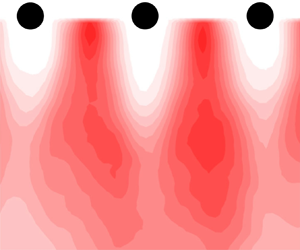Published online by Cambridge University Press: 20 December 2021

An experimental study is performed to investigate the effects of the extensional rheological properties of drag-reducing wormlike micellar solutions on the vortex deformation and turbulence statistics in two-dimensional (2-D) turbulent flow. A self-standing 2-D turbulent flow was used as the experimental set-up, and the flow was observed through interference pattern monitoring and particle image velocimetry. Vortex shedding and turbulence statistics in the flow were affected by the formation of wormlike micelles and were enhanced by increasing the molar ratio of the counter-ion supplier to the surfactant, ξ, or by applying extensional stresses to the solution. In the 2-D turbulent flow, extensional and shear rates were applied to the fluids around a comb of equally spaced cylinders. This induced the formation of a structure made of wormlike micelles just behind the cylinder. The flow-induced structure influenced the velocity fields around the comb and the turbulence statistics. A characteristic increase in turbulent energy was observed, which decreased slowly downstream. The results implied that the characteristic modification of the 2-D turbulent flow of the drag-reducing surfactant solution was affected by the formation and slow relaxation of the flow-induced structure. The relaxation process of the flow-induced structure made of wormlike micelles was very different from that of the polymers.